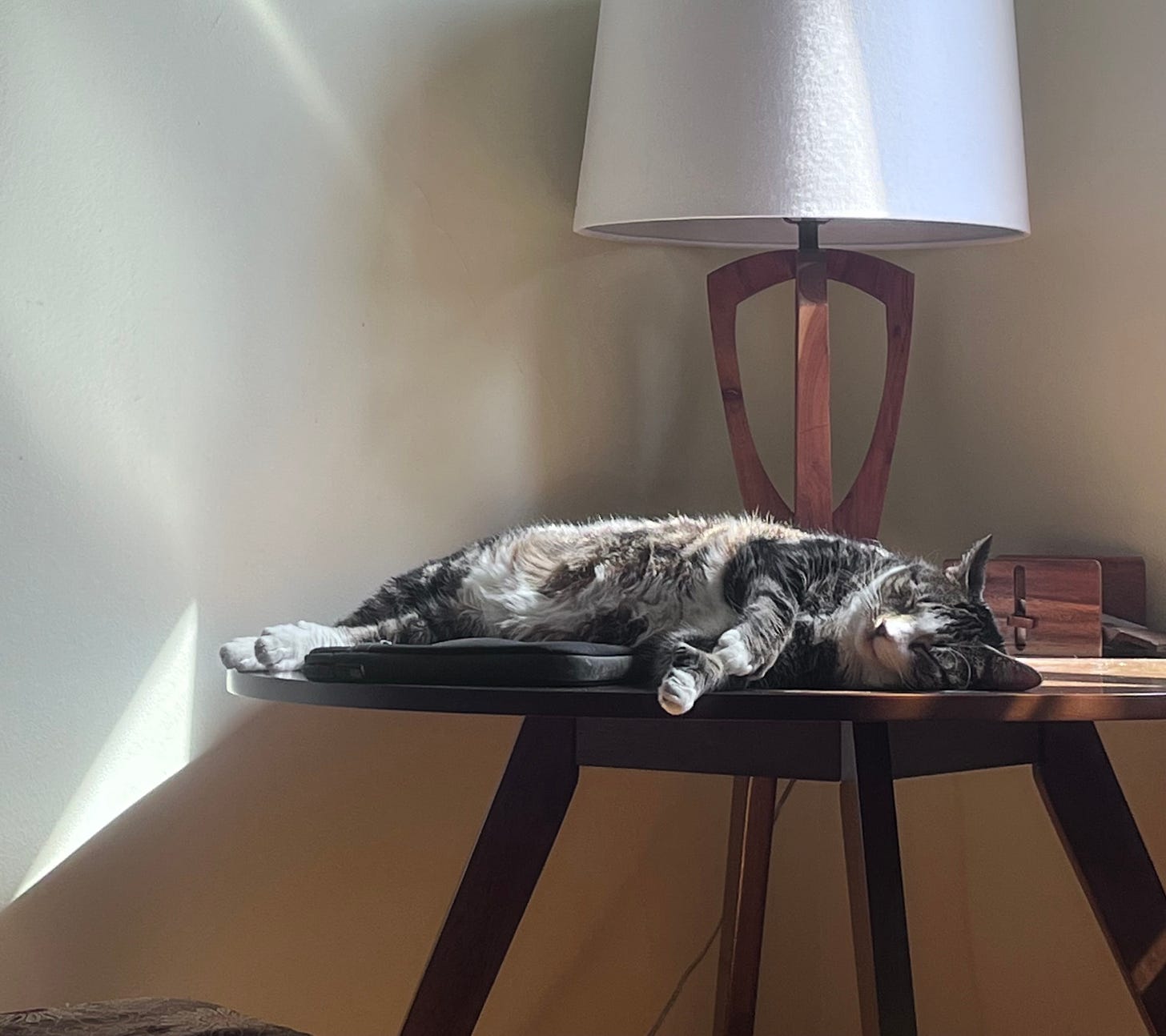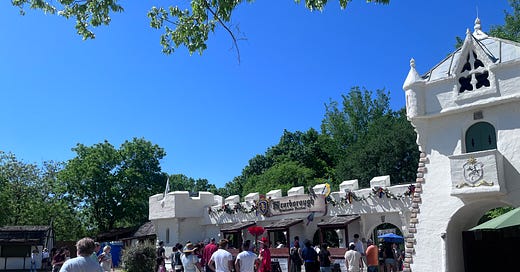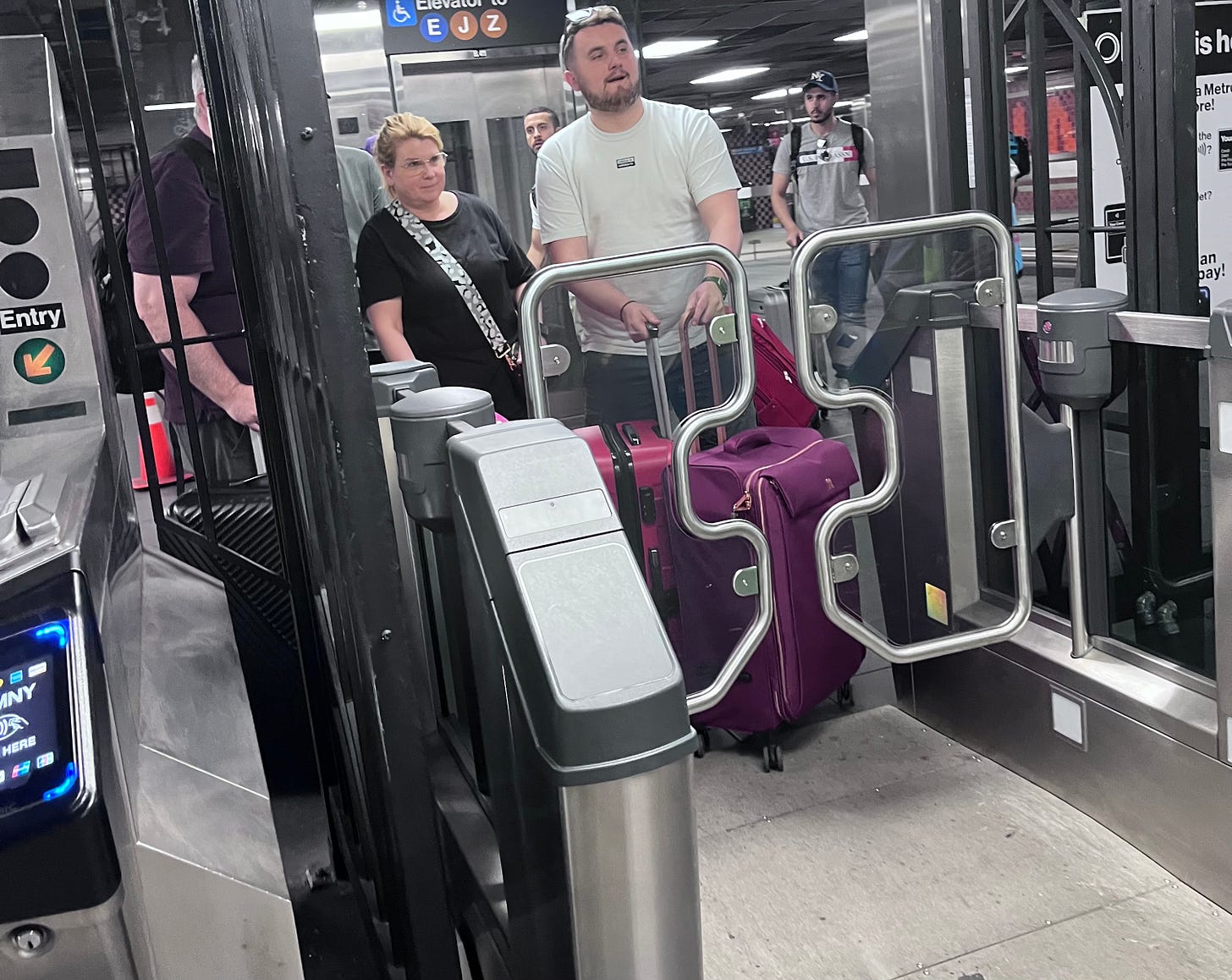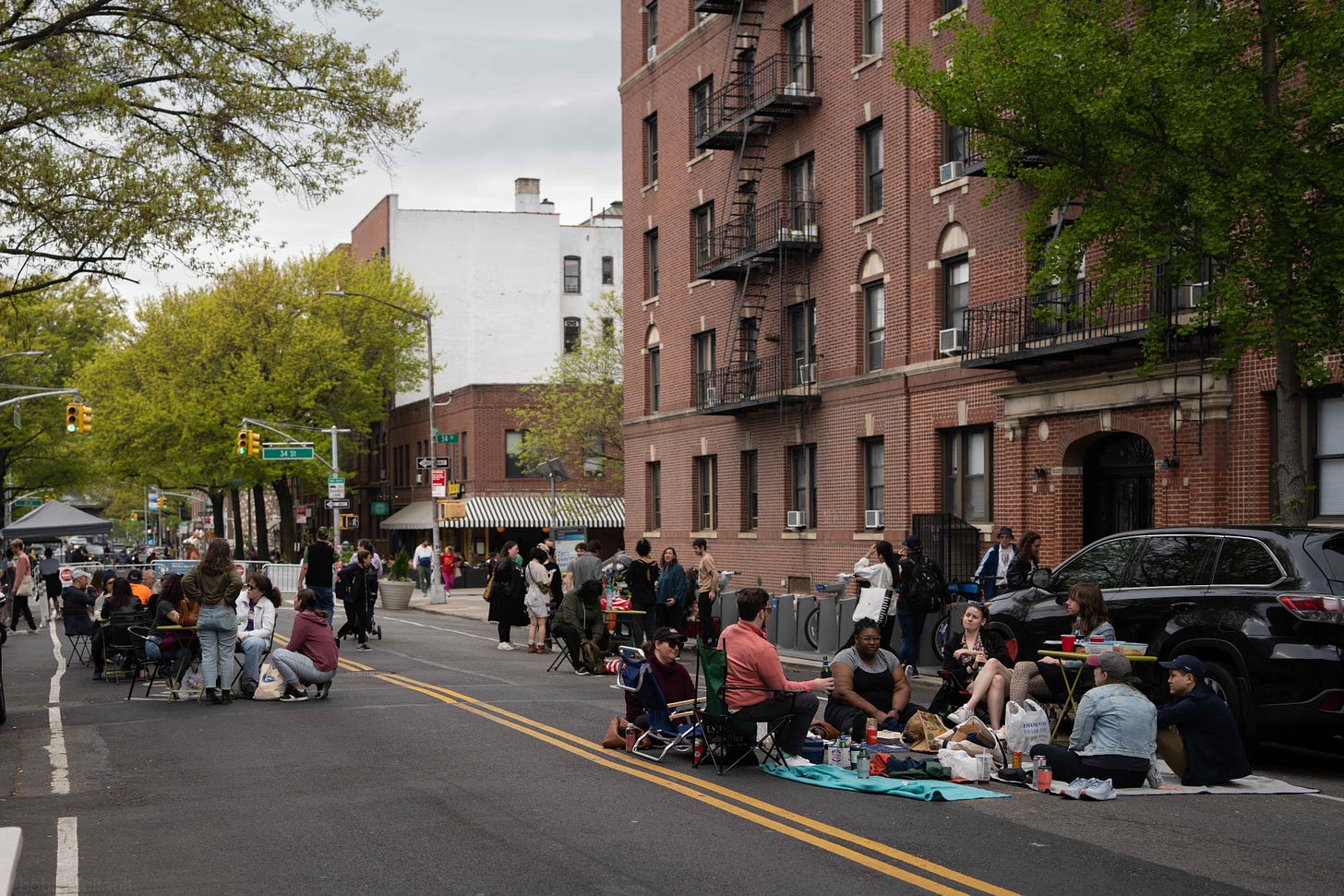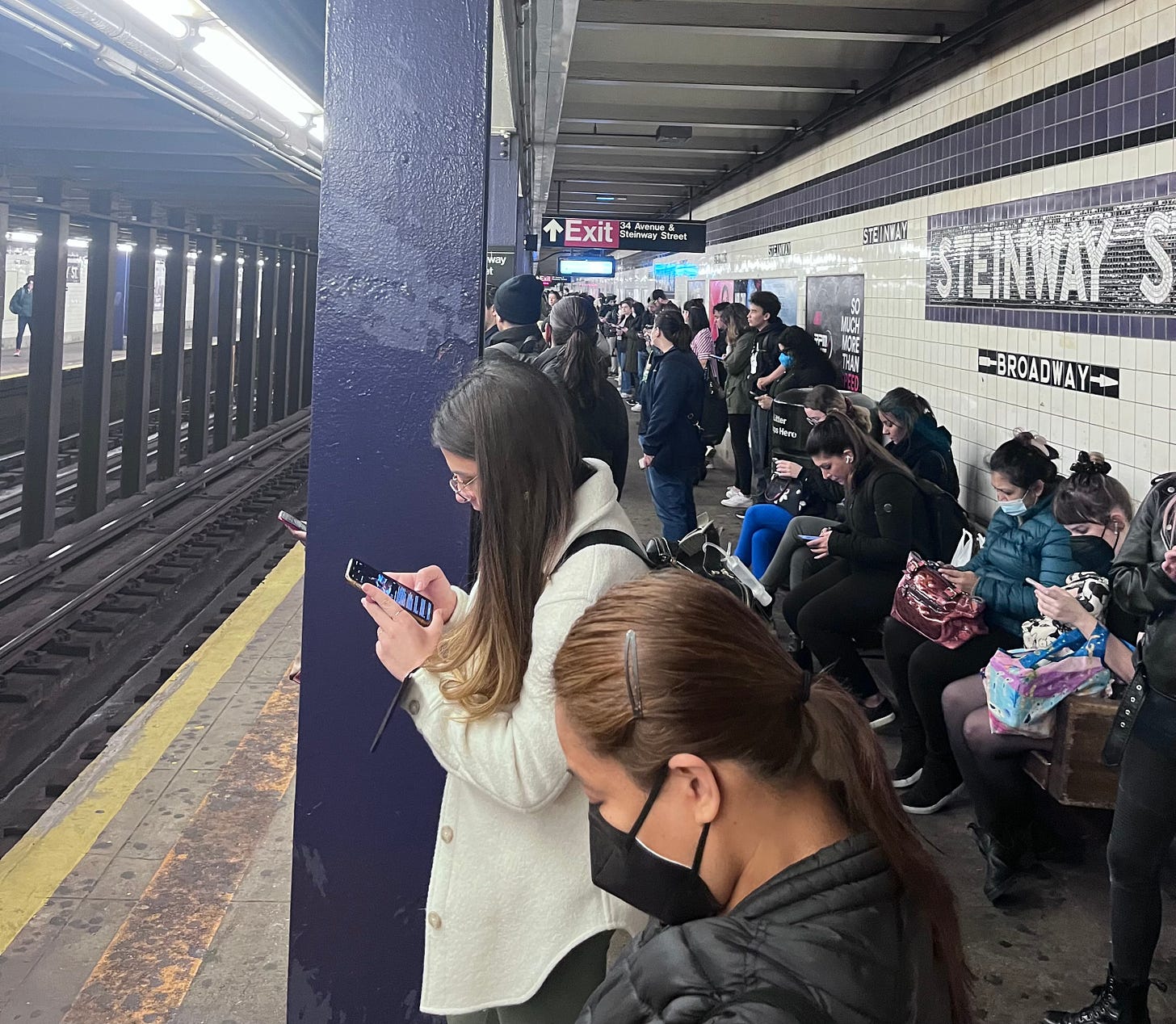Γειά σου
And welcome to this newsletter.
It's where I (John Surico) talk each month about cities & all their discontents: streets, environment, energy, cultures, people, food, form, etc. This month, we cover:
- A fare evasion enforcement redux;
- The uneven resurgence in ridership;
- The future vision for 31st Ave;
& much, much more.
No major Streetbeat updates this month — we’re sticking with our usual format, and welcoming a bunch of new readers. (Hello folks!)
Lots going on, but all I really want to talk about with people is the 35-acre Scarborough Renaissance Festival I attended outside of Dallas earlier this month. It was my first time attending anything like this as an adult — and the faire was one of the zaniest, funnest days I’ve had in recent memory. It’s also surreal to experience medieval planning for a few hours, where leather artisans, cirque performers and mead pubs are all walkable from one another, connected by a few dirt paths. Contrast that with the endless field of parked cars just outside the castle gates, and you get a good sense of how far from that we’ve strayed, and the ends we go to to reenact the past. Texas is a great place for that.
Anyway, here’s what’s going this month:
Fare evasion mania
I don’t know what chapter we’re on in the book of public transit’s recovery since the Covid-19 crisis, but we’ve most certainly entered the fare evasion fanaticism phase. This is when public transit agencies gloat about the bulkier, fancier fare gates they’ve installed. Or the ‘very fabric’ that fare evasion — or the act of intentionally not paying for transit — rips at in our society when left unchecked. The language gets existential, and also, weird. (Like the ‘hardening’ of stations.)
Curbing fare evasion is nothing new — in fact, this very same conversation happened in the late 2010s, right before Covid hit. And just like then, there were genuine concerns about criminalizing poverty, over-policing Black and Brown communities, and whether this was all worth it in the end. But the difference now is that: a) we just went through a crisis where low-income riders of color — overwhelmingly the target of these crackdowns — quite literally kept the trains and buses running; and b) operating budgets are a fraction of what once was, which offers a visceral price tag to this whole business that didn’t exist before.
A few weeks ago, my editor at Bloomberg CityLab and I were wondering: why does fare evasion constantly eat up our attention? So I asked this question to advocates, experts, and transit officials, at a time when cities are increasingly calling BS on the concept of even having a fare in the first place. And then we teamed up with Bloomberg Government to piece it all together.
Semester update
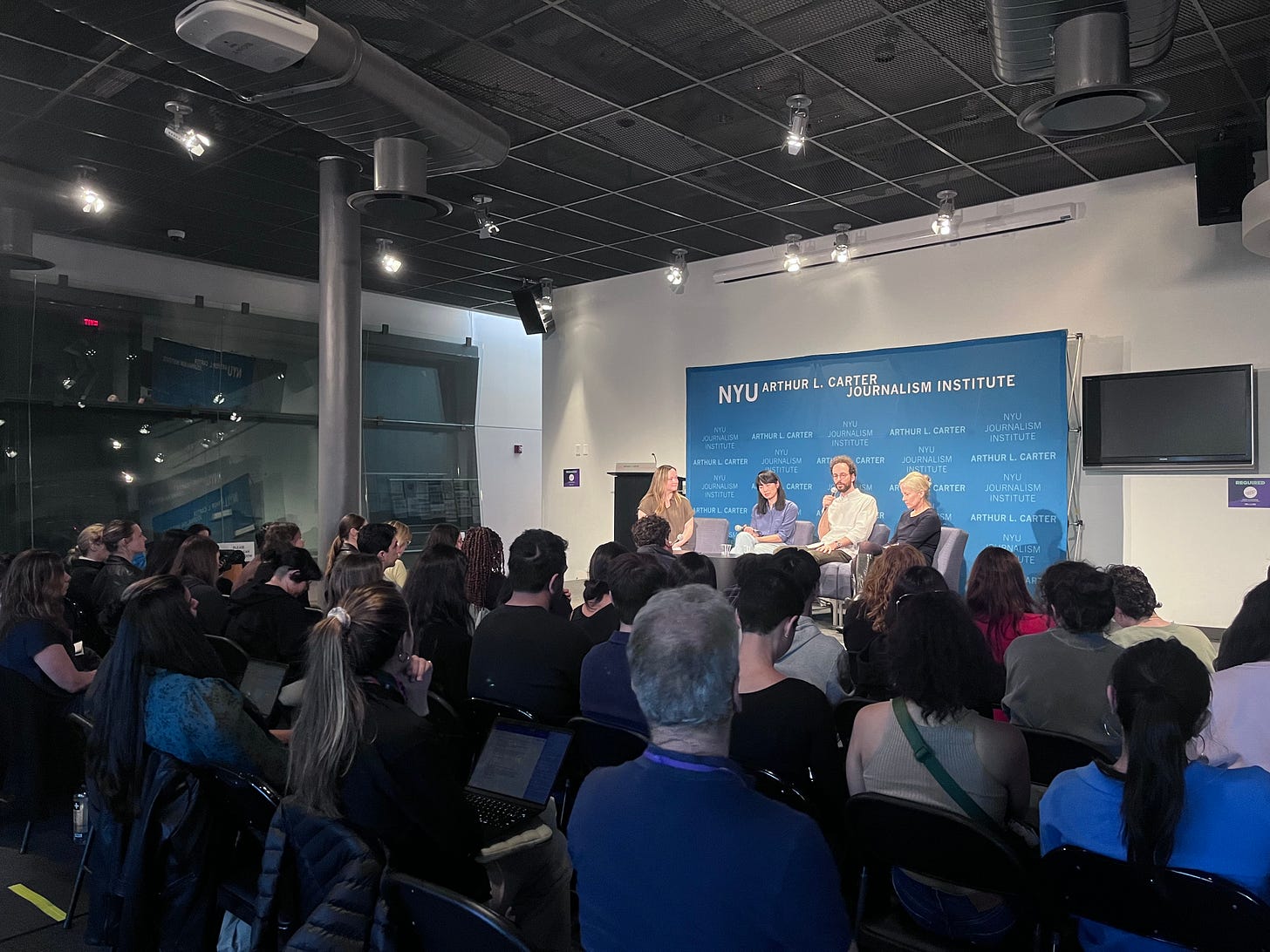
If you see me IRL the days after reading this, I may be in a deep haze.
That is because it’s the end of the academic calendar year at New York University, and the rush of editing 13 3,000-word stories so 13 students can graduate is real. That’s the end goal of my capstone class about reporting on the issues facing New York City—it’s the most extensive journalistic undertaking that students have made in their careers thus far, and it all unfolds in a matter of weeks. (I wrote mine about Bloomberg’s last year as mayor, to date myself.)
We’ve got some great stories this semester, covering everything from well-being and green space to doulas and AI in fashion. I’ll share them here once they’re finished next month, like the proud class dad I am. But in the meantime, a brief update: after concluding an interim position as undergraduate academic advisor these last few months (in addition to teaching), I have assumed the role of events coordinator for NYU Journalism.
That means I now oversee the wide swath of programming we have going on at the mothership of 20 Cooper Square, including, most recently, panels on pitching the likes of The New Yorker, The Atlantic and Curbed; a career fair with 30 media outlets in attendance; and live podcast recordings with Audible and NPR stars. It’s an exciting role to have, especially as media continues to contort and change dramatically. I’m quite new to production (I take my lessons from Angela and the 31st Ave Open Street), but it’s great to help shape the events I would’ve loved to have seen when I was a student all those years ago.
And folks, most are public. So if you’re in the area, stop on by.
OSA: A future vision
It’s been the busiest launch month in the 31st Ave Open Street’s four-year lifespan. We did tabling, and hosted a successful new volunteer social, hopefully the first of many. We appeared in a bunch of local press. (I even broke the fourth wall of media for one). And after years of asks, we finally saw the installation of official city signs for this public space project—one a reminder of the parking rules; another explaining what this project actually is. That led to a jam-packed first weekend, with tons of neighbors coming out to say how happy they were to see us again. (A wacky ADA lawsuit and burdensome rules, be damned.)
But the true highlight has been the long-awaited announcement that New York City’s Department of Transportation (NYCDOT) is ready to redesign 31st Ave. We’re not yet sure what the project will entail, but it’s being pegged as a ‘bike boulevard’ in official documents. Only a few of these designs exist in the city: essentially, they reroute and slow traffic flow on residential blocks through one-way streets and certain turn-offs. (Here’s a good video of one near us.) That then offers more space for protected bike lanes and other public space amenities.
We’re still in the outreach phase, but we’ve scrapped together a list of what we’re going to push for. (The Open Street becoming a permanent plaza is one such ideal.) And we’re sharing the survey everywhere it can be shared. Next week, we’ll host a get-out-the-vote rally with elected officials, who are now calling for a district-wide street safety plan. (I went into the uproar around a child’s death last month — this month, there was another.) We’re expecting a big turnout.
If you read this newsletter, care about this line of work and have come to visit me or 31st Ave, I do encourage you to fill out the city’s survey. We take great pride as a volunteer group in demonstrating to the public a new vision of what our streets can be — and we truly believe that it’s one that’s here to stay. Join us!
Bright Side: Ridership rebounds
If you’re in a city while reading this, you may have noticed that certain spaces have been a bit more crowded lately. April saw a few major milestones for public transit’s ridership — a sign of many things: that people are exploring their city more; that more is going on in their city; that more people are visiting cities; that remote work’s full five-day control is tapering off; and that transit systems are doing a good job attracting folks back. (Be it better service; a safer, cleaner environment; or worsening car traffic.)
This month, New York and London were the big news.
In early April, news came that London had surpassed its pre-pandemic rail ridership — meaning more people are riding the tracks of the Big Smoke right now than they were in 2019. (Wild, if you think how far that fall was — and how many strikes there have been lately.) And that’s due in large part to the opening of the Elizabeth Line, or Crossrail, a major east-west line that did wonders for the system’s capacity. It’s a telling sign that new projects, if actually effective for people’s commutes, can help transit agencies lift themselves out of a funk.
In late April (on 4/20, nonetheless), New York City hit a record high of 4 million daily riders — the most since March 2020. (Thank Gothamist for that hazy wordplay.) Now, that’s still 1.5 million short of 2019 figures, but it’s trending up. And that’s warts and all: subpar headways, delays, etc. Imagine what would happen if transit agencies nailed the user experience — not just during rush hour, but throughout the day, as our systems respond to new work patterns.
Many cities still have a ways to go. (The APTA dashboard, using Transit’s data, has me refreshing and refreshing.) And there are a million X factors at play here: is a city more attractive to in-person work? (Houston seems to be.) Is a city struggling to attract people back? (San Francisco seems to be.) What does a city even have to do to get back to 100% pre-pandemic ridership?
And then, the question that’ll really trip you up: is 100% even important anymore?
On the Radar
The Crosswalk Vigilantes (60 Second Docs)
I’ve followed the work of the Crosswalk Collective in Los Angeles for some time. (And hope to see some of their work when I’m there next week for a wedding.) This group of ordinary citizens who don hi-viz vests and construction helmets, equipped with traffic cones and caution tape, on a mission to paint their own way to Vision Zero — or a world of zero traffic fatalities — when and where the city refuses to. They embody the practice of tactical urbanism, or the movement of people taking it upon themselves to create the city they want to see.
In this case: one that just has… safe streets to cross.
I’ve only read about the Collective, but I hadn’t seen video of them in action. It shows a different power in their work — their faces blurred out of fear of retribution from city officials, who take great strides to erase any crosswalk they put in place. There are reasons why the city wants to do it themselves; Arnold Schwarzenegger valiantly filling a pothole outside of a house this month, to later find out that it was for utility work, shows us that. But this guerrilla act should be seen as an asset, not a nuisance. Instead of cracking down, how about working together to figure out how to scale safety measures in priority areas? Now doesn’t really seem like the time to do otherwise.
Streetbeat Gig Board
Wanna post a job? Submit it here.
***
CultureHouse, a placemaking nonprofit that enlivens vacant spaces in the Boston area (I wrote about their neat work years back!), is looking for an operations person. (Boston, MA)
Sustrans, arguably the most influential active transport organizing body across the pond, needs a new head of design and engineering. (It’s the old role of Giulio Ferrini, whose work I always appreciated.) (London, UK)
Another Open Street staffing up, this time in Harlem. (Manhattan, NY)
The Other 5th, the business group that runs a popular Open Street in Brooklyn’s Park Slope, has paid positions to operate it. Email them here. (Brooklyn, NY)
Kita Monthly
